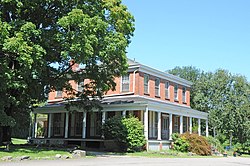| Walsh-Havemeyer House | |
| U.S. National Register of Historic Places | |
 | |
  | |
| Location | 10 Plympton St., New Windsor, New York |
|---|---|
| Coordinates | 41°29′20.3″N 74°1′4.95″W / 41.488972°N 74.0180417°W / 41.488972; -74.0180417 |
| Area | 2.06 acres (0.83 ha) |
| Built | 1835 |
| Architectural style | Greek Revival |
| NRHP reference No. | 10000101 |
| Added to NRHP | March 23, 2010 |
Walsh-Havemeyer House, also known as the Plympton House, is a historic home located at New Windsor in Orange County, New York. It was built about 1835 and subsequently expanded and modified.
The house consists of a two-story brick main block with two-story brick wing. The interior retains a number of notable Greek Revival treatments dating to the period of original construction. Also on the property is a frame privy and cast-iron fence.
It was listed on the National Register of Historic Places in 2010.
History

The house sits on the former farm of patriot Robert Boyd, Jr. (1734 — 1804). In June 1775, Boyd built a water-powered forge on the south side of the nearby Vale of Avoca. He was a Scottish immigrant to New Windsor before the Revolutionary War, and with his father, Robert Boyd, Sr. (1703 — 1786), continued their trade as blacksmiths. After 1761, they obtained a hundred-acre farm on the northern end of William Chamber's patent. Boyd's gun smithery manufactured bayonets, gun barrels muskets, as he had received a contract from the revolutionary authorities to produce them. He was paid three pounds and fifteen shillings. By February 1776, their gun smithery was remarked as one of the best in the colonies. However, he had difficulty with assistance at the forge, and sent agents abroad to secure more workmen, a mission that proved to be unsuccessful. He was a member of the New Windsor Committee of Safety, along with Samuel Brewster, a blacksmith on Moodna Creek. After the Revolution, he converted the works into a plaster mill and retired.
In 1790, George Clinton sold his grist and saw mill in the Vale to Hugh Walsh, who extended his property to Boyd's. The Havemeyer family were German entrepreneurs who owned property in New Windsor that they maintained in the summer months.
References
- ^ "National Register of Historic Places". WEEKLY LIST OF ACTIONS TAKEN ON PROPERTIES: 3/22/10 THROUGH 3/26/10. National Park Service. 2010-04-02.
- William E. Krattinger (October 2009). "National Register of Historic Places Registration: Walsh-Havemeyer House". New York State Office of Parks, Recreation and Historic Preservation. Retrieved 2010-08-05. See also: "Accompanying 10 photos".
- "Brooklyn Museum". www.brooklynmuseum.org. Retrieved 2020-03-16.
- ^ "Avoca, the Vale: A Historical Reminiscence of the Old Toll Gate". The Newburgh Sunday Telegram. 8 December 1906.
- ^ Ruttenber, Edward Manning (1911). History of the Town of New Windsor, Orange County, N.Y. Newburgh, New York: Newburgh Journal Print. pp. 16, 52, 53, 158.
| U.S. National Register of Historic Places in New York | ||
|---|---|---|
| Topics |   | |
| Lists by county |
| |
| Lists by city | ||
| Other lists |
| |
This article about a historic property or district in Orange County, New York, that is listed on the National Register of Historic Places, is a stub. You can help Misplaced Pages by expanding it. |
- Houses on the National Register of Historic Places in New York (state)
- Houses completed in 1835
- Greek Revival houses in New York (state)
- Houses in Orange County, New York
- National Register of Historic Places in Orange County, New York
- Buildings and structures in New Windsor, New York
- Hudson Valley, New York Registered Historic Place stubs